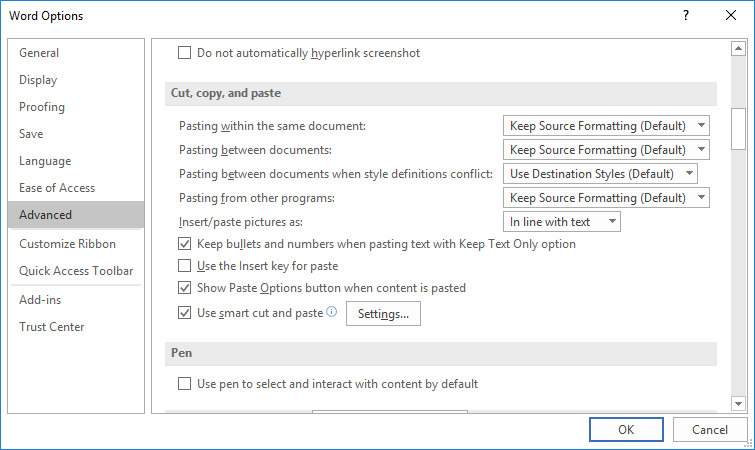Please Note: This article is written for users of the following Microsoft Word versions: 2007, 2010, 2013, 2016, 2019, and 2021. If you are using an earlier version (Word 2003 or earlier), this tip may not work for you. For a version of this tip written specifically for earlier versions of Word, click here: Extra Space after Quotation Mark when Pasting.
Written by Allen Wyatt (last updated June 26, 2021)
This tip applies to Word 2007, 2010, 2013, 2016, 2019, and 2021
Richard cuts and pastes quotations quite a bit. If he types a quotation mark and then pastes text right after the quotation mark, Word automatically puts a space between the quotation mark and the text he's pasting. Richard then has to go back and delete the added space. He wonders how he can stop this behavior in Word.
Actually, the behavior is "by design" in Word. It is part of what Microsoft refers to as "smart cut and paste." It means that Word tries to figure out whether it should add or subtract a space from things you are cutting or pasting. This can, for some people and some purposes, cause confusing results.
You can turn off smart cut and paste (and thereby stop Word from adding the unwanted space after the quotation mark) by following these steps:

Figure 1. The Advanced options of the Word Options dialog box.
If you prefer, you could leave the check box selected (in step 4) and simply modify what things smart cut and paste does for you. You do that by clicking on the Settings button at the right of the option.
WordTips is your source for cost-effective Microsoft Word training. (Microsoft Word is the most popular word processing software in the world.) This tip (8759) applies to Microsoft Word 2007, 2010, 2013, 2016, 2019, and 2021. You can find a version of this tip for the older menu interface of Word here: Extra Space after Quotation Mark when Pasting.

Do More in Less Time! An easy-to-understand guide to the more advanced features available in the Microsoft 365 version of Word. Enhance the quality of your documents and boost productivity in any field with this in-depth resource. Complete your Word-related tasks more efficiently as you unlock lesser-known tools and learn to quickly access the features you need. Check out Microsoft 365 Word For Professionals For Dummies today!
A great way to work on different parts of the same document at the same time is to create windows. These function as ...
Discover MoreThere are lots of little "gotchas" that can make the difference between a finished document and a polished document. One ...
Discover MoreSome fractions Word automatically converts to single characters, some it doesn't. Here's why that happens and what you ...
Discover MoreFREE SERVICE: Get tips like this every week in WordTips, a free productivity newsletter. Enter your address and click "Subscribe."
There are currently no comments for this tip. (Be the first to leave your comment—just use the simple form above!)
Got a version of Word that uses the ribbon interface (Word 2007 or later)? This site is for you! If you use an earlier version of Word, visit our WordTips site focusing on the menu interface.
Visit the WordTips channel on YouTube
FREE SERVICE: Get tips like this every week in WordTips, a free productivity newsletter. Enter your address and click "Subscribe."
Copyright © 2026 Sharon Parq Associates, Inc.
Comments